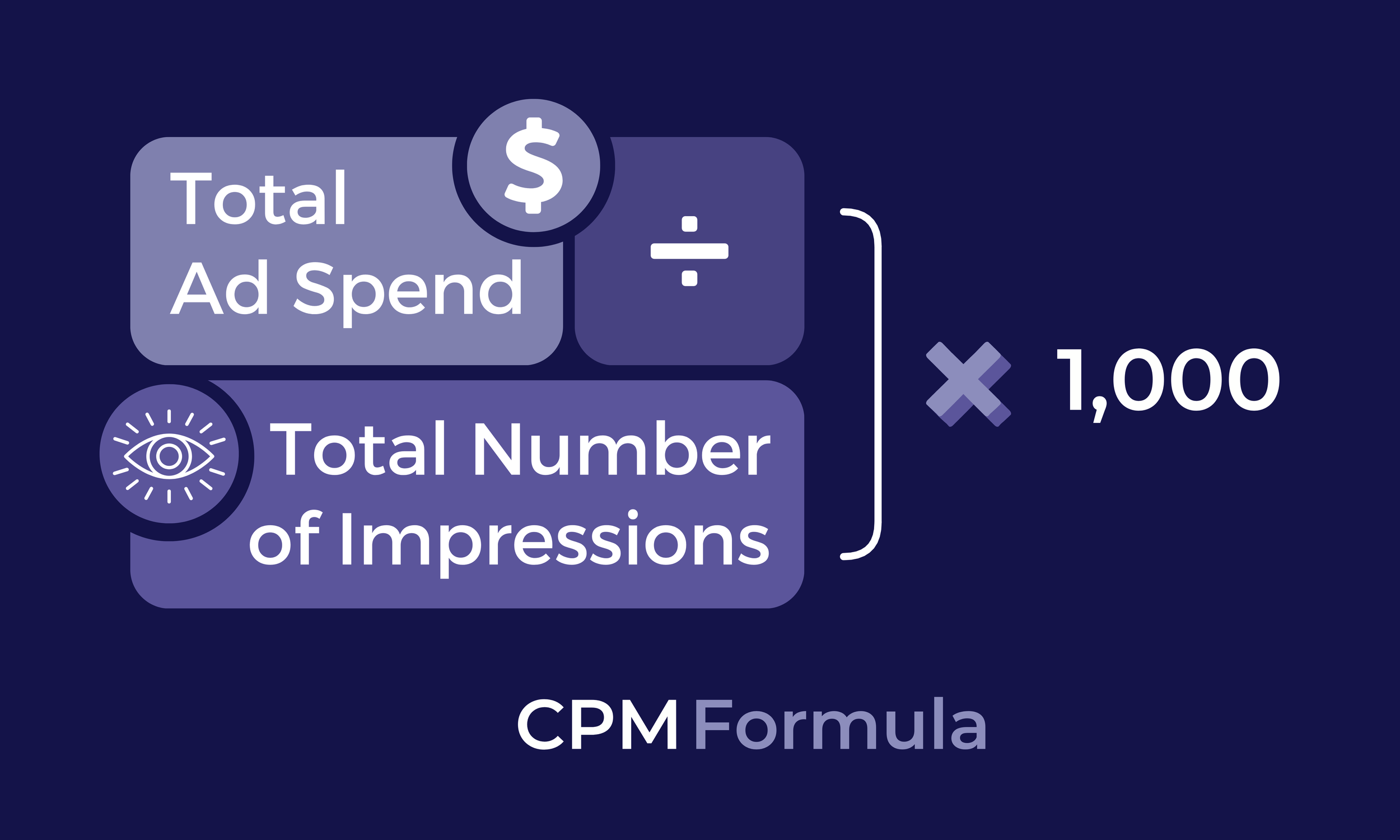What is CPM in Advertising + How to Calculate It?
| Pathlabs Marketing |
| July 24, 2023 |
Understanding the metrics that drive success is crucial in the digital marketing world. One such metric is CPM, which stands for Cost Per Mille or Cost Per Thousand.
In this blog post, we will explore what CPM is, its significance in marketing, where it is used, how to calculate it, and the factors that impact it.
What is CPM in Advertising?
CPM, cost per mille, is a common metric in digital advertising campaigns, which looks at the cost an advertiser pays for every 1,000 impressions on their advertisement.
Marketers often use CPM when running advertisements on websites and programmatic platforms like Google Ads, Linkedin, Facebook, The Trade Desk, and more.
The way marketers use CPM goes like this: Marketers build campaigns within ad buying platforms, selecting locations, channels/formats, target audiences, and optimization strategies to achieve their goals best.
Upon launch, the buying platform (DSP) bids on a user that falls within the target audience and serves an ad to them during their browsing experience. CPM is a way to evaluate how expensive these users are.
Why Is CPM an Important Metric for Advertisers?
CPM is important because it can help marketers evaluate the cost efficiency of their campaigns and optimize them.
To visualize, imagine a marketer ran a Facebook Ad campaign and they ended up paying $60 and receiving 12,000 impressions, a CPM of $5.
If the marketer wants to attain a lower CPM, they can use the original $5 as a baseline and run a new, similar campaign, maybe just changing up the CTA or targeting parameters.
If the campaign gets a similar result of 12,000 impressions, but the marketer pays only $45, making it a CPM of about $3.75, the marketer can deem this a positive change and lean into the new strategy. If it were to be higher or the same as the baseline, they can go back to the drawing board and figure out a new strategy for increasing impressions for a lower cost.
“Overall, CPM is an essential metric for understanding the cost-effectiveness of campaigns. That said, CPM should not be used in isolation to understand campaign performance for campaigns that are not exclusively focused on reach goals.
For example, with campaigns that are working toward a conversion goal, evaluating conversion performance and then optimizing to increase conversion performance can often raise the CPM but will achieve performance more aligned with the goal.”
Where Is CPM Used?
CPM, or Cost Per Mille, is a metric commonly used with programmatic advertising methods like display, native, video, and audio ads. It is also sometimes used on social media.
Marketers who are specifically running campaigns that receive a significant number of impressions tend to use CPM.
In some cases, CPM is either accompanied by or substituted with cost per click (CPC), a comparable metric that focuses on the amount marketers pay for each clicks their ads receive.
How to Calculate CPM
To calculate CPM, the marketer divides the total cost of the advertising campaign by the number of impressions generated and then multiplies the result by 1000.
The CPM Formula
CPM = (Total Cost of Ad Campaign / Number of Impressions) * 1000
Calculating CPM Step-By-Step
To calculate CPM, the marketer:
Determines the total cost of the advertising campaign.
Counts the number of impressions generated by the campaign.
Divides the total cost by the number of impressions.
Multiplies the result by 1000 to get the cost per thousand impressions (CPM).
Examples of CPM Calculation
Let's say a display advertising campaign costs $2,000 and generates 200,000 impressions.
The marketer will perform the following calculation:
CPM = ($2,000 / 200,000) * 1000 CPM = $10
In this case, the cost per thousand impressions (CPM) would be $10. This means that the advertiser is paying $10 for every 1,000 impressions of their ad.
What Is a Good CPM?
The concept of a "good" CPM varies depending on the campaign objective and the marketers running the campaign.
Some marketing teams may have the goal of getting the lowest CPM possible. In comparison, other teams may be willing to spend upwards of $15 to $20 just for 1,000 impressions from a very specific audience.
“Overall, every campaign has its own constraints that raise or lower the CPM from the industry standard. For example, a Meta awareness campaign could use an impressions goal strategy and have a significantly lower CPM than another campaign with a clicks goal strategy. Of course, the clicks campaign would have more clicks but would be giving up impressions or a lower CPM as a result.
Typically, the rule of thumb is awareness campaigns should try to keep their CPM lower, but conversion campaigns should be okay with higher CPMs.”
What Is a CPM Floor?
A CPM floor price, in digital advertising, refers to the minimum cost per thousand impressions (CPM) that an advertiser is willing to pay for their ad to be displayed. It acts as a safeguard to ensure that ad inventory is not sold below a certain value, helping publishers maintain a certain level of revenue for their impressions.
The concept of a "good" CPM varies depending on the campaign objective and the marketers running the campaign.
Some marketing teams may have the goal of getting the lowest CPM possible. In comparison, other teams may be willing to spend upwards of $15 to $20 just for 1,000 impressions from a very specific audience.
Factors That Impact CPM
Several factors influence CPM rates, including the target audience, ad placement, channel, ad server, seasonality, competition, audience targeting capabilities, and the overall quality and relevance of the ad content.
Strategies to Improve CPM
To improve CPM performance, advertisers should cover the following bases:
Build Out and Utilize Target Audience Personas
The platforms marketers use to run campaigns using CPM as a metric are often programmatic, offering precise targeting capabilities. To make the most of programmatic advertising, marketers should develop a clear understanding of their target audience by creating an audience persona. This involves gathering data on the demographics, behaviors, and interests of the ideal users they want to target.
Having a well-defined audience persona helps marketers better understand their audience and enables the programmatic software better to deliver ad content to the most pertinent users.
Leverage Past Campaign Insights and Historical Campaign Data
“At Pathlabs, when running CPM campaigns, we tap into our abundance of historical campaigns and data. Referencing these allows us to accurately forecast the cost for our clients and campaign, then strategize accordingly.
Why set an arbitrary CPM goal when you have the data to craft a more feasible baseline? ”
Don’t Use CPM as a Standalone Tactic
As previously mentioned, CPM is useful; however, it can only speak to the number of times an ad loads and appears to users. Even though an ad gets 1,000 impressions, it doesn’t mean those who see it are actually actively viewing it, engaging, and converting.
So, having other KPIs and attribution measures in place can paint a better picture of how ad campaigns perform.
What is eCPM vs. CPM?
While CPM focuses on the cost per thousand impressions for advertisers, eCPM is primarily used by publishers to evaluate their revenue per thousand impressions. eCPM considers additional factors such as fill rate, click-through rate (CTR), and overall revenue generated, providing publishers with insights into their ad monetization strategies.
In Conclusion…
CPM is a cost structure that many marketers utilize in their advertising campaigns. It looks at how much a marketer is spending for every 1,000 impressions they receive.
This metric is important because it helps marketers put into perspective their campaign results concerning how much they are spending and how much they are actually getting their ad to load and be seen.
Marketers wanting to use CPM should ensure that they approach this method, understanding that it will take time and optimization to get the exact results they seek. Additionally, when analyzing performance, they shouldn’t put all their trust and decision-making power in this metric. Instead, they should use CPM as a compliment to other performance metrics.












